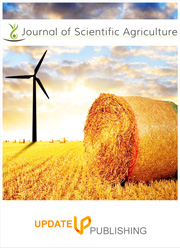Morphological and pathogenic characterization of Fusarium species causing common bean root rot in Uganda
DOI:
https://doi.org/10.25081/jsa.2024.v8.8849Keywords:
Common bean, Disease incidence, Disease prevalence, Fusarium root rot, PathogenicityAbstract
Fusarium root rot (FRR) of common bean occurs in Africa, Central and South America, and causes yield losses of up to 86%. Recently, FRR-like wilt symptoms were observed in Uganda’s agroecology zones. To identify the causal pathogen, we conducted surveys in seven agroecology zones to determine the prevalence and incidence of the reported disease. During the surveys, diseased roots were collected for pathogen isolation. Fungal strains were characterized using colony color, mycelial growth rate and microscopic structures such as conidia and microconidia. The pathogenicity of 99 strains on five bean varieties was determined in artificially inoculated soils in the screenhouse. Based on field symptoms, the observed wilting was identified to be Fusarium root rot, the prevalence of which varied across agroecologies, with the highest (95%) in the Karamoja pastoral zone (KP) and the lowest (40%) in West Nile farming system (WN). Similarly, the incidence of FRR was highest (87%) in KP, and lowest (20%) in WN. Fusarium strains differed in growth rate, colony color, shape and size of microscopic structures. All evaluated strains were pathogenic on common bean and caused severities of 0.9 to 98.3%. Further studies are required to identify the isolated strains at the species level using molecular tools.
Downloads
References
Abawi, G. S., & Corrales, M. A. P. (1990). Root rots of beans in Latin America and Africa:Diagnosis, research methodologies, and management strategies. Cali Colombia: Centro Internacional de Agricultura Tropical.
Arias, M. M. D., Leandro, L. F., & Munkvold, G. P. (2013). Aggressiveness of Fusarium species and impact of root infection on growth and yield of soybeans. Phytopathology, 103(8), 822- 832. https://doi.org/10.1094/PHYTO-08-12-0207-R
Broughton, W. J., Hernández, G., Blair, M., Beebe, S., Gepts, P., & Vanderleyden, J. (2003). Beans (Phaseolus spp.) model food legumes. Plant and Soil, 252, 55-128. https://doi.org/10.1023/A:1024146710611
Burlakoti, P., Rivera, V., Secor, G. A., Qi, A., Del Rio-Mendoza, L. E., & Khan, M. F. R. (2012). Comparative pathogenicity and virulence of Fusarium species on sugar beet. Plant Disease, 96(9), 1291-1296. https://doi.org/10.1094/PDIS-10-11-0908-RE
Buruchara, R., Mukankusi, C., & Ampofo, K. (2010). Bean disease and pest identification and management: A hand book for small scale seed producers. Kampala, Uganda: International Center for Tropical Agriculture.
Chiang, K. S., Liu, H. I., & Bock, C. H. (2017). A discussion on disease severity index values. Part I: warning on inherent errors and suggestions to maximise accuracy. Annals of Applied Biology, 171(2), 139-154. https://doi.org/10.1111/aab.12362
Chopada, G. B., Singh, P., & Chandulal, K. (2015). Cultural and morphological variability among Fusarium oxysporum f. sp. Lycopersici causing wilt of tomato in south Gujarat region. Archives of Phytopathology and Plant Protection, 48(2), 104-110. https://doi.org/10.1080/03235408.2014.882558
Igbal, Z., Pervez, M. A., Saleem, B. A., Ahmad, S., Dastt, A. A., & Saleem, A. (2010). Potential of Fusarium mangiferae as an etiological agent of mango malformation. Pakistan Journal of Botany, 42(1), 409-415.
Kalyebara, M. R., Mugisha, K. S., Andima, D., & Nasirumbi, L. (2006). The impact of improved bush bean varieties and management technologies in Uganda. Kampala, Uganda: International Center for Tropical Agriculture.
Kiprop, E. K., Mwang'ombe, A. W., Baudoin, J. P.., Kimani, P. M., & Mergeai, G. (2002). Cultural characteristics, pathogenicity and vegetative compactibility of Fusarium udum isolates from pigeon peas (Cajanus cajan (L) Millsp) in Kenya. European Journal of Plant Pathology, 108, 147-154. https://doi.org/10.1023/A:1015012702846
Kristensen, R., Torp, M., Kosiak, B., & Holst-Jensen, A. (2005) Phylogeny and toxigenic potential is correlated in Fusarium species as revealed by partial translation elongation factor 1 alpha gene sequences. Mycological Research, 109(2), 171-186. https://doi.org/10.1017/S0953756204002114
Mandal, M., Rana, D., & Misra, D. K. (2018). Studies on cultural properties of Fusarium isolates causing panama wilt of banana under West Bengal. Journal of Pharmacognosy and Phytochemistry, 7(3), 833-840.
Miklas, P. N., Kelly, J. D., Beebe, S. E., & Blair, M. W. (2006). Common bean breeding for resistance against biotic and abiotic stress: From classical to MAS breeding. Euphytica, 147, 105-131. https://doi.org/10.1007/s10681-006-4600-5
Moya-Elizondo, E. A., Rew, L. J., Jacobsen, B. J., Hogg, A. C., & Dyer, A. J. (2011). Distribution and prevalence of Fusarium crown rot and common root rot pathogens of wheat in Montana. Plant Disease, 95(9), 1099-1108. https://doi.org/10.1094/PDIS-11-10-0795
Nutter, F. W., Teng, P. S., & Shokes, F. M. (1991). Disease assessment terms and concepts. Plant Disease, 75, 1187-1188.
Paparu, P., Acur, A., Kato, F., Acam, C., Nakibuule, J., Musoke, S., & Mukankusi, C. (2018). Prevalence and incidence of four common bean root rots in Uganda. Experimental Agriculture, 54(6), 888-900. https://doi.org/10.1017/S0014479717000461
Paparu, P., Kato, F., Acam, C., Nakibuule, J., Nkuboye, A., Musoke, S., & Mukankusi, C. (2020). Morphological and pathogenic characterisation of Sclerotium rolfsii, the causal agent of Southern blight disease on common bean in Uganda. Plant Disease, 104(8), 2130-2137. https://doi.org/10.1094/PDIS-10-19-2144-RE
Trabelsi, R., Sellami, H., Gharbi, Y., Krid, S., Cheffi, M., Kammoun, S., Dammak, M., Mseddi, A., Gdoura, R., & Triki, M. A. (2017). Morphological and molecular characterization of Fusarium spp. associated with olive trees dieback in Tunisia. 3 Biotech, 7, 28. https://doi.org/10.1007/s13205-016-0587-3
Tusiime, G. (2004). Variation and detection of Fusarium solani f. sp. phaseoli and quantification of soil inoculum in common bean fields. Doctoral Dissertation. Makerere University.
Weiland, J. E., Beck, B. R., & Davis, A. (2013). Pathogenicity and virulence of Pythium species obtained from forest nursery soils on Douglas-fir seedlings. Plant Disease, 97(6), 744-748.
Wilkus, E. L., Teran, J. C. B. M., Mukankusi, C. M., & Gepts, P. (2018). Genetic patterns of common-bean seed acquisition and early-stage adoption among farmer groups in western Uganda. Frontiers in Plant Science, 9, 586. https://doi.org/10.3389/fpls.2018.00586
Published
How to Cite
Issue
Section
Copyright (c) 2024 Samuel Erima, Moses Nyine, Richard Edema, Allan Nkuboye, Justine Nakibuule, Pamela Paparu

This work is licensed under a Creative Commons Attribution-NonCommercial-NoDerivatives 4.0 International License.



 .
.